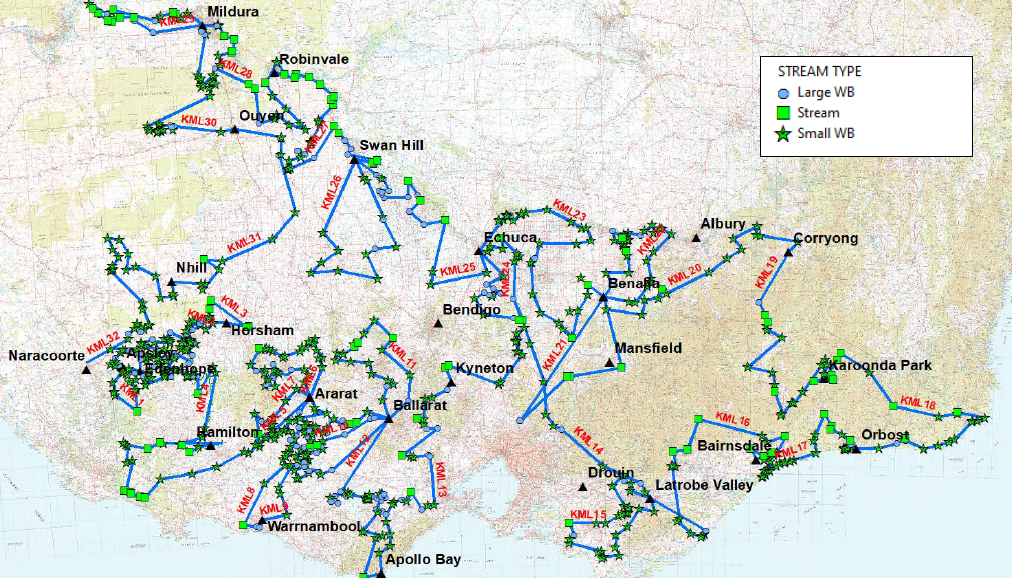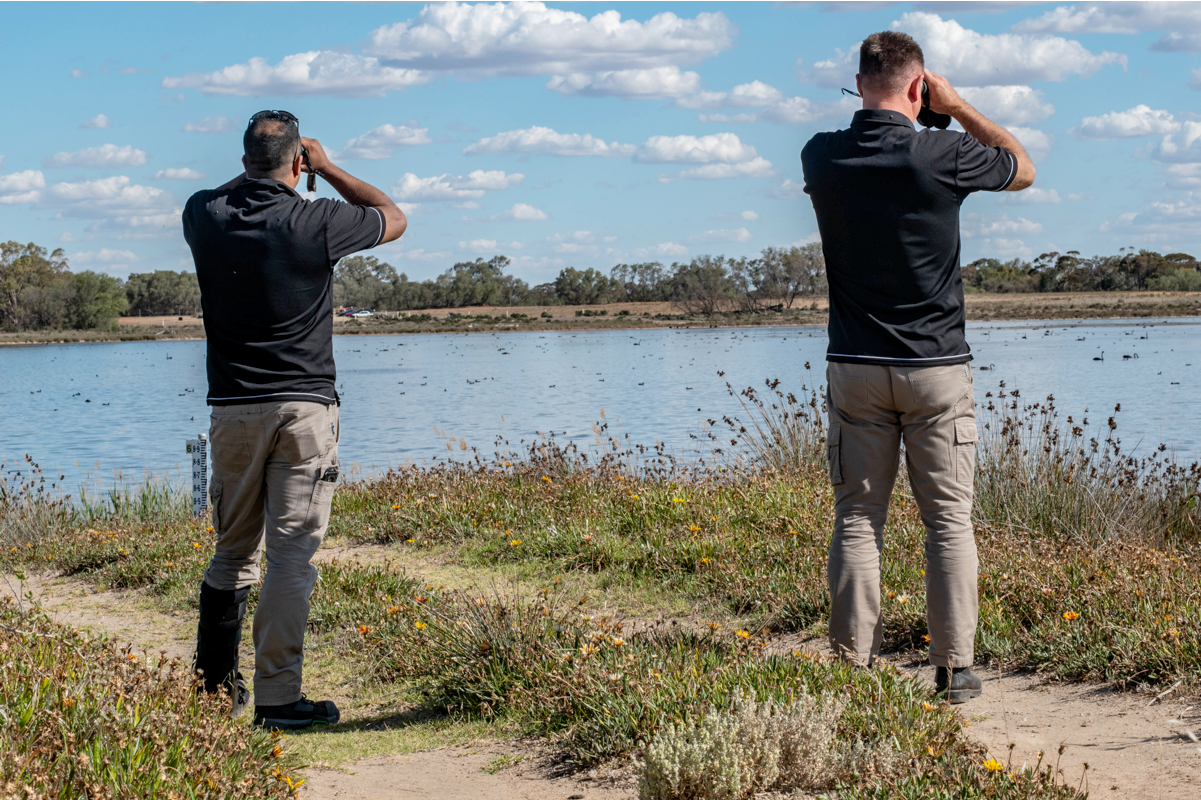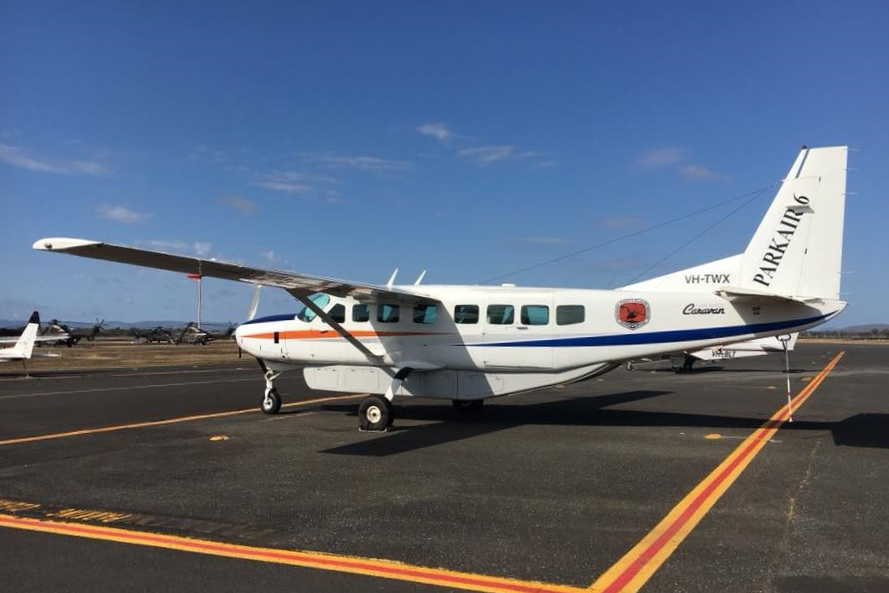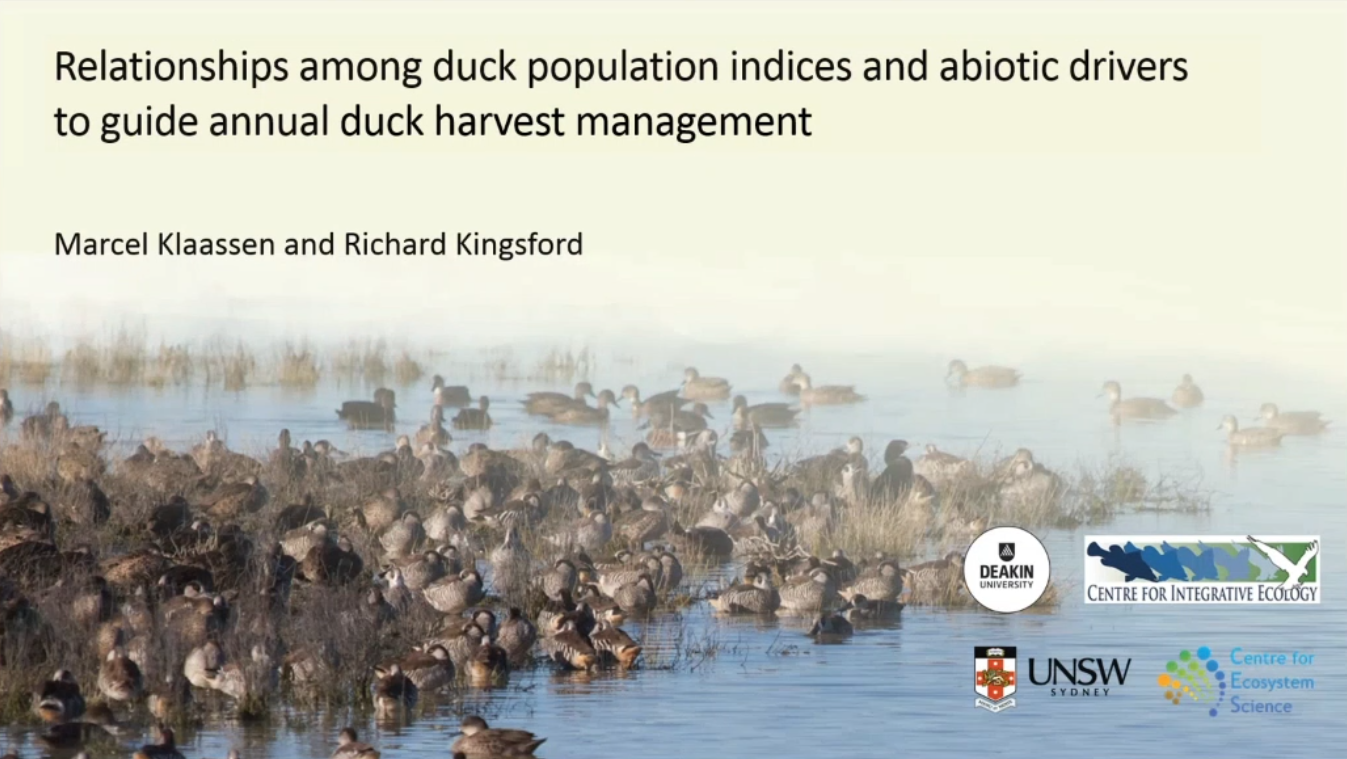Duck Research
The Game Management Authority conducts the following research on game ducks across the state.
Adaptive Harvest Management
In 2010, an expert Scientific Panel was convened by the Adaptive Harvest Management subcommittee of the Hunting Advisory Committee to recommend a robust scientific approach to sustainable waterfowl harvesting in Victoria that would:
- consider previous work and evaluate the current harvest approach in Victoria
- investigate other approaches adopted throughout the world and relevant scientific research
- into adaptive and other wildlife harvest management models consider the existing literature on the ecology and biology of Australian waterfowl
- populations (habitat utilisation, population dynamics, movement patterns, etc.) whendeveloping an approach on harvest management
- identify a scientific credible harvest management model that can be delivered at minimal cost.
The report below details the comittee's findings and recommendations for an adaptive harvest model.
The Victorian government has committed to implementing the Waterfowl Conservation Harvest Model to ensure the sustainable hunting of game ducks.
GMA commissioned ARI and NSW DPI researchers to undertake the review. A report has been prepared and makes a series of recommendations to improve and modernise the approach.
The review proposes a staged approach to implementation across the immediate, mid and longer-terms, scaling up as more information becomes available and ultimately allowing the model to operate in a more sophisticated way.
The 2019 expert panel completed its review of the 2017 proposal and found that the proposed population model was theoretically sound and appropriate, and it made several other recommendations. Government accepted all but one of the recommendations.
The interim harvest model (Relationships among duck population indices and abiotic drivers to guide annual duck harvest management) was a tool to inform the annual duck hunting season arrangements up until the 2024 duck hunting season, including the daily bag limit.
The model used information from long-running duck population data to explore the relationship between abundance and habitat availability for Victoria and eastern Australia. This generates five indices that provide information on the current population status of ducks in eastern Australia, which are given points. The relationship between the total indices point score and historic seasonal arrangements produces a recommended daily bag limit for the upcoming season.
The model was developed by two members of the 2019 expert panel that reviewed the proposed revised approach to implementing Adaptive Harvest Management (AHM) (Professor Marcel Klaassen and Professor Richard Kingsford), in consultation with the community. The interim harvest model was developed to inform decisions on duck bag limits while AHM is being prepared for implementation. The AHM requires several more years of data before it can function effectively.
For more information on how the interim harvest model works, watch the below video presentation from Professor Marcel Klaassen, one of the creators of the model.
The Victorian Government is developing a more rigorous method for regulating the recreational harvest of game ducks in Victoria, requiring robust estimates of the total abundances of game ducks in Victoria. This is being achieved by undertaking comprehensive annual aerial surveys of the state’s water bodies. In total, 800 wetlands and 60 sections of waterways are surveyed.
This is the largest and most comprehensive aerial survey of game ducks undertaken in Victoria. Counts are conducted on farm dams, natural wetlands, rivers and sewerage ponds across regional Victoria.
The helicopter approaches each waterbody at approximately 75 – 90 km/hr at 30-50 metres from the ground, causing the ducks to ‘flush’ and take to the air. Differences in bird size, flight behaviours and colouration can then be seen, allowing individual species to be accurately identified and counted.
The monitoring method uses a ‘double-observer’ system where two highly experienced counters simultaneously observe and record (on a specialised keypad) the number of each species of game ducks sighted at each waterbody.
Satellite imaging is then be used to determine how much water is in the landscape, which informs an estimate of the total abundance of each game duck species in the state.
This program was designed by wildlife scientists from the Arthur Rylah Institute for Environmental Research (ARI).
The monitoring program will be used to support AHM for setting sustainable duck hunting arrangements each year.
This report outlines the design of a robust aerial (helicopter) monitoring program to estimate the abundance of game ducks. Total abundance estimates are a critical input into the population model for Adaptive Harvest Management. The report recommends the theoretical survey design should be tested and refined following collection of an initial set of monitoring data in pilot study.
This report also analyses historical game duck harvest data in Victoria and has found that both bag limit and season length are positively related to harvest size.
An evaluation of the monitoring program was conducted by the Arthur Rylah Institute for Environmental Research. In addition, Dr Steve McLeod, an expert who works in this field, and Dr Thomas Prowse (mathematical ecologist and Research Associate, University of South Australia) and Professor Richard Kingsford (Director of the Centre for Ecosystem Science, University of New South Wales) have separately reviewed the survey design and approach to data analysis. Both found that the program is robust and rigorous and is an effective way of counting ducks and provides critical data to ensure that duck season arrangements remain sustainable. Recommendations for refinements to the monitoring program contained in the reviews have been incorporated into the monitoring program.
Visit the Tracking Victorian game ducks website for more detailed information.
The GMA, in partnership with researchers from Deakin University, is conducting new research to better understand the movements, survival and behaviour of four of Victoria’s most important game duck species (Pacific Black Duck, Australian Wood Duck, Grey Teal and Chestnut Teal).
The research involves attaching a small solar-powered satellite tracking device to 400 individual game ducks (100 on each of the species studied).
The tracking devices capture information about the duck’s location, movement, breeding, feeding and resting patterns 24 hours a day.
This project aims to identify the drivers of game duck movement in relation to the fluctuating water availability in the Australian landscape. It will also record how long game ducks survive and provide insights into the primary causes of mortality.
This knowledge will help model game duck population dynamics to inform Adaptive Harvest Management (AHM) for sustainable duck hunting in Victoria. It will also provide important information for waterfowl conservation more broadly and disease management.
Members of the public can follow the progress of the research, see where the ducks are travelling, view interviews with researchers and get more information about the project at the Tracking Victorian game ducks website.
Under the Sustainable Hunting Action Plan 2021-2024, the Department of Jobs, Skills, Industry and Regions (DJSIR) commissioned a report to inform setting sustainable game duck harvests.
The research, undertaken by Dr Thomas Prowse, recommends a precautionary annual proportional harvest quota of 10 to 20 per cent of the Victorian game duck population sizes estimated from surveys of each species in spring. Modelling suggests that this harvest level should be low enough to ensure populations of the studied species do not drop below 20 per cent of their carrying capacity in any year, even when environmental conditions are unfavourable.
Visit DJSIR – Game Hunting in Victoria for a copy of the report, titled: Conservation and sustainable harvest models for game duck species.
Game duck abundance monitoring program (Aerial survey)
The GMA’s annual Victorian game duck abundance survey uses a combination of aerial and ground counts to track the size of populations over time and help improve our knowledge of waterfowl ecology.
Helicopters are used to count the species and number of ducks on over 850 farm dams, natural wetlands, rivers and sewerage ponds.
The survey was designed by wildlife scientists from the Arthur Rylah Institute for Environmental Research, Department of Energy, Environment and Climate Action (ARI). It is the largest and most comprehensive aerial survey of game ducks undertaken in Victoria.
Samples of waterbodies are drawn using a stratified random sampling design with the strata being the waterbody type and size as well as region (North, South, East, West).
Satellite imaging is then used to determine how much water is in game duck habitats in Victoria, which informs calculation of an estimate of the total abundance of each game duck species in the state.
Results from the monitoring program are used to support Adaptive Harvest Management for setting sustainable duck hunting arrangements each year.
The surveys are taking place from Tuesday 21October until Friday 8 November 2025, inclusive at over 850 randomly-selected waterbodies throughout regional Victoria. The duration of the survey and flight schedule may change from day to day, depending on weather conditions or other factors.
The information gained by this monitoring program will benefit wildlife conservation by improving our understanding of what drives waterfowl populations and data is used in setting sustainable annual duck harvesting arrangements.
It will also provide important indicators about the health of our waterways and the broader environment.
These surveys show that farms dams provide critical habitat for game duck species, including Black Ducks, Grey Teal and Wood Ducks which together make up 90% of the annual hunting harvest.
To accurately estimate game duck abundance, it is important to survey farms dams given their importance in supporting a large proportion of the total abundance.
The helicopter approaches each waterbody at approximately 75 – 90 km/hr at 30-50 metres from the ground, causing the ducks to ‘flush’ and take to the air. Differences in bird size, flight behaviours and plumage colouration can then be seen which allows individual species to be accurately identified and counted.
The survey method uses a ‘double-observer’ system where two experienced counters simultaneously observe and record (on a specialised keypad) the number of individuals and each species of game ducks sighted at each waterbody.
There are also many areas where helicopter access isn’t possible (sensitive livestock, powerlines and infrastructure). To allow counts of game ducks in these areas, double-observer ground counts are undertaken.
Farm dams on private land need to be surveyed to ensure an accurate estimate of game duck populations. This will involve helicopters flying at low levels, at approximately 30-50 metres, over the farm dam for a very short time and for no longer than is necessary.
It will take no longer than a minute or two to survey a typical-sized farm dam,. The survey team will only record data on the number of ducks and the species present and wetland characteristics, such as how full the dam is and whether any vegetation is present. No other information is recorded when flying over the property.
An experienced wildlife survey company and helicopter operator have been contracted to undertake the aerial survey. Minimising disturbance to stock, protecting assets and ensuring public safety are the highest priorities.
Each water body will be individually assessed via satellite imagery and the helicopter at high altitude before being surveyed at a lower altitude. Cattle will not be cornered in paddocks and any dams with horses, calves or lambs will not be surveyed to avoid stress or injury to stock.
Low-flying helicopters will not be flying within 300 metres of residences, as per Civil Aviation Safety Authority (CASA) regulations.
Any questions or feedback can be made via research@gma.vic.gov.au or 136 186.

Monitoring game duck populations
The aerial survey is part of a monitoring program to estimate the total abundance of game ducks in Victoria, to help ensure duck hunting remains sustainable. The monitoring program will also improve our broader understanding of waterfowl ecology.
The aerial monitoring survey is carried out by experienced wildlife biologists, who recorded the presence and number of game ducks on wetlands, sewerage ponds, farm dams, creeks and rivers and irrigation channels throughout the state.
The results will be used to inform adaptive harvest management (AHM) to set sustainable duck season arrangements in the future. This is the largest and most comprehensive survey of game ducks undertaken in Victoria.
2024
Abundance estimates for game ducks in Victoria 2024
2023
Abundance estimates for game ducks in Victoria 2023
2022
Abundance estimates for game ducks in Victoria 2022
2021
Abundance estimates for game ducks in Victoria 2021
2020
 The Summer Waterbird Count is conducted in February each year.
The Summer Waterbird Count is conducted in February each year.
Since 1987, various government agencies and departments have monitored selected Victorian wetlands to provide information on game duck distribution and abundance, waterbird breeding and, importantly, any concentrations of rare or threatened species and colonially breeding waterbirds. The collected data is used to consider whether wetlands should be closed to duck hunting to protect non-game or breeding waterbirds, including waterfowl.
Reports
Victorian Duck Season Priority Waterbird Count 2025
Victorian Duck Season Priority Waterbird Count 2024
Victorian Duck Season Priority Waterbird Count, 2021
The annual Eastern Australian Waterbird Survey is one of the largest wildlife surveys in Australia.
A team of researchers fly along ten survey bands (each 30 km in width) stretching from central Queensland down to southern Victoria, counting over 50 species of waterbirds on up to 2,000 wetlands.
The aim of the survey is to collect data that will help monitor changes in the distribution and abundance of waterbird species, including game ducks and threatened species, and the extent of waterbird habitat.
The survey provides critical information on the health of waterbirds and wetlands throughout eastern Australia and will help inform the seasonal arrangements for Victorians duck hunting seasons.

Waterfowl wounding monitoring
The GMA conducts research to monitor trends in wounding of game ducks as a result of hunting.
The Waterfowl Wounding Monitoring Program, which began in 2022, involves trapping game ducks immediately following Victoria’s duck hunting season and x-raying them for embedded shotgun pellets.
The results provide a wounding index only, not the actual wounding rate. The wounding index will be used to monitor trends in wounding over time.
This research is a key action in Victoria’s Sustainable Hunting Action Plan 2021-24 (SHAP), which commits to monitoring waterfowl wounding to measure the success of the Waterfowl Wounding Reduction Action Plan.
The following reports detail the results of the Waterfowl Wounding Monitoring Program.
2025 Waterfowl Wounding Monitoring Program report
2024 Waterfowl Wounding Monitoring Program report
The GMA recently established a Wounding Reduction Working Group, with the aim of providing advice that will assist the GMA in developing a Gamebird Wounding Reduction Action Plan for consideration by government. The Working Group is chaired by Professor Andrew Fisher and comprises representatives from hunting, animal welfare, a firearms industry representative and a Shotgunning Education Program trainer.
On 29 July 2021, the Working Group held its inaugural meeting, which included two presentations on research and actions that have occurred in Denmark to address gamebird wounding.
Wounding (crippling) of waterbirds by shotgun shooting: some scientific background from Danish research
Professor Jesper Madsen is the Head of the Centre for Adaptive Nature Management in the Department of Bioscience at Aarhus University, Denmark. His areas of expertise cover wildlife ecology, migratory waterbird ecology and management, and adaptive natural resource management. His presentation covered the recent history of research into wounding in Denmark; the extent of wounding with a focus on gamebirds and the major causes of wounding; the contribution of wounding in total losses (harvest) caused by hunting and their inclusion in harvest estimates to ensure sustainability; and the role of research and monitoring in developing a management approach in order to achieve change.
Hunters and their involvement in wounding
Niels Søndergaard is the Director of Education and Advisory at the Danish Hunters Association. His educational qualifications include wildlife management and forestry, and has previously worked as an adviser to the Danish Ministry of Environment on practical hunting, wildlife management, forestry and nature. His presentation focused on: the Danish hunting community’s role in recognising and addressing waterfowl wounding; the hunting community taking a leadership role in changing culture and hunter behaviour; regulatory and non-regulatory approaches adopted in Denmark to reduce wounding; and the continuous improvement sought by the hunting community.
Each year, the GMA produces a report on its assessment of waterbirds deposited by animal welfare activists at Treasury Place during the annual duck season.
The birds are examined and radiographed by GMA staff to determine the number of birds carrying embedded shotgun pellets as an indicator of shooting being the cause of death.
2025 - Assessment of waterbirds deposited at Treasury Place
Harvest reports and bag surveys
The Game Management carries out a range of surveys to collect data on duck and quail populations across the state. These surveys inform decisions about setting rules and regulations for hunting seasons, to ensure sustainability in game hunting in Victoria.
Phone surveys help us to estimate the number of duck and quail harvested during the hunting season. These surveys gather information on a wide range of hunting behaviours including about hunter effort, days spent in the field, location, and the number of duck and quail harvested.
The results of these surveys are published annually in a report on the Estimates of harvest for duck and Stubble Quail in Victoria.
We also collect data on the actual daily take by a sample of hunters on the opening weekend, by surveying hunters’ bags. This research is an important component of assessing the impact of the duck hunting season on populations of game species.
Similar surveys have been conducted on opening weekend at Victorian wetlands since 1972 to determine both hunter success and the species involved in opening weekend harvests.
Elements of the hunter bag surveys are informed by A field guide for ageing and sexing Victorian native game birds.
The field guide describes ageing and sexing characters of the Victorian game birds (eight species of duck, and Stubble Quail, focusing on attributes that can be recorded from wings and tail feathers from birds harvested by hunters.
Each year the Game Management Authority conducts phone surveys to estimate the number of deer, duck and quail harvested in the state.
The following reports detail the results of the duck surveys.
2024
Estimates of harvest for duck and Stubble Quail in Victoria 2024
2023
Estimates of harvest for duck and Stubble Quail in Victoria 2023
2022
Estimates of harvest for duck and Stubble Quail in Victoria 2022
2021
Estimates of harvest for duck and Stubble Quail in Victoria 2021
2020
Estimates of harvest for duck and Stubble Quail in Victoria 2020
2019
Estimates of harvest for duck and Stubble Quail in Victoria 2019 (PDF version)
Hunter's Bag Survey: 2019 Victorian duck hunting season (PDF version)
2018
Estimates of harvest for duck and Stubble Quail in Victoria 2018 (PDF version)
Hunter's Bag Survey: 2018 Victorian duck hunting season (PDF version)
2017
Estimates of harvest for duck and Stubble Quail in Victoria (PDF version)
Hunter's Bag Survey: 2017 Victorian duck hunting season (PDF version)
Estimates of harvest for deer, duck and quail from 1985 to 2015: Combining mail and telephone survey results (PDF version)
2016
Game Birds
Estimates of harvest for duck and quail in Victoria (PDF Version)
Hunter's Bag Survey: 2016 Victorian duck hunting season (PDF Version)
2015
Game Birds
Estimates of harvest for duck and quail in Victoria (PDF version)
Hunter's Bag Surveys: 2014 and 2015 Victorian duck hunting seasons (PDF version)
2014
Estimates of harvest for deer, duck and quail in Victoria (PDF version)
2013
Estimates of harvest for deer, duck and quail in Victoria (PDF version) (Word Version)
2012
Estimates of harvest for deer, duck and quail in Victoria (PDF version) (Word Version)
2011
Estimates of harvest for deer, duck and quail in Victoria (PDF version) (Word Version)
2010
Estimates of harvest for deer, duck and quail in Victoria (PDF version) (Word Version)
2009
Estimates of harvest for deer, duck and quail in Victoria (PDF version) (Word Version)
Ageing and sexing Victorian game birds
This report identifies key features that can be used to determine age and sex of nine game bird species (eight ducks and the Stubble Quail).
These age and sex characteristics were identified by examining museum skins, and wing and tail specimens obtained from hunters during opening weekend of the 2017 and 2018 duck hunting seasons.
The report doubles as a field guide with commissioned paintings showing the differences between males and females, and between adults and juveniles.
This information can be used to inform decisions about the hunting season, such as the duration of the season and daily bag limits.
This field guide equips the waterfowl hunter with information to assist them in identifying the age, sex and moulting stages in harvested game ducks.
This information can provide insight into a population's productivity, current status and recruitment from season to season.
All waterfowl hunters in Victoria must be competent in identifying different waterbird species. However, this guide is not intended to educate hunters on species identification, but rather to illustrate methods of determining age, sex and moult.
The GMA monitors the opening weekend harvest of ducks using wing samples and tail feathers provided by duck hunters. These samples are analysed using the Field Guide for Ageing and Sexing Victorian Native Game Birds, to determine the species, age, sex and stage of moult of harvested birds. The age of the birds allows us to monitor breeding success from the previous year. The data collected from this research helps to monitor duck hunting and the health of our game duck populations.
Assessing waterbird susceptibility
The report, Assessing waterbird susceptibility to disturbance by duck hunters in Victoria, provides a transparent process for determining bird species most likely to be negatively affected by disturbance from duck hunting. The report includes species susceptibility rankings and is a useful objective tool to make informed decisions in managing duck hunting where significant concentrations of rare or threatened species are present at wetlands during the hunting season.
The original report has been revised to include the latest estimates of conservation status. Please see Assessing waterbird susceptibility to disturbance by duck hunters in Victoria (2022 update). This report includes the listing of two game species, Australasian Shoveler and Hardhead, as threatened under the Victorian Flora and Fauna Guarantee Act 1988. In addition, during 2018-2019, the conservation status of fauna species listed as threatened under the Flora and Fauna Guarantee Act 1988 were reviewed using IUCN criteria as part of the adoption of an Australia-wide common assessment method for classifying threatened species. This process resulted in some revisions to the categories of threat applied to some species in Victoria. Accordingly, the susceptibility to disturbance rankings were recalculated using the new information, resulting in some changes to the susceptibility score achieved by some species and corresponding changes to the species rankings.
State game reserve audit
State Game Reserves (SGRs) are an important part of Victoria's park and reserve system. These reserves were set aside for the conservation of wildlife and to allow for the hunting of game species during the open season. There are currently 200 SGRs across Victoria which cover an area of about 75,000 hectares.
The first State Game Reserves were purchased using licence fees collected from duck hunters who identified early on that the draining of wetlands was seriously impacting waterbird habitat and populations. Jack Smith Lake Game Reserve was the first SGR to be proclaimed in 1958 and ever since these reserves have played an important role in conservation and recreation. In addition to game hunting opportunities during the open season, these reserves provide recreational opportunities for water sports, camping, bird-watching and fishing all year round.
Critically, this network of reserves plays an important conservation role at both the local and international scale. Seventy SGRs support threatened species and eighteen SGRs are listed as wetland of significant importance under the international RAMSAR convention.
To better inform the management of these important reserves, the Game Management Authority, with the assistance of Parks Victoria, have conducted a state-wide audit of the reserves. The results of this audit are provided in the report below.
Page last updated: 04 Dec 2025
